child seat CHRYSLER TOWN AND COUNTRY 2008 5.G Owners Manual
[x] Cancel search | Manufacturer: CHRYSLER, Model Year: 2008, Model line: TOWN AND COUNTRY, Model: CHRYSLER TOWN AND COUNTRY 2008 5.GPages: 531, PDF Size: 4.51 MB
Page 12 of 531
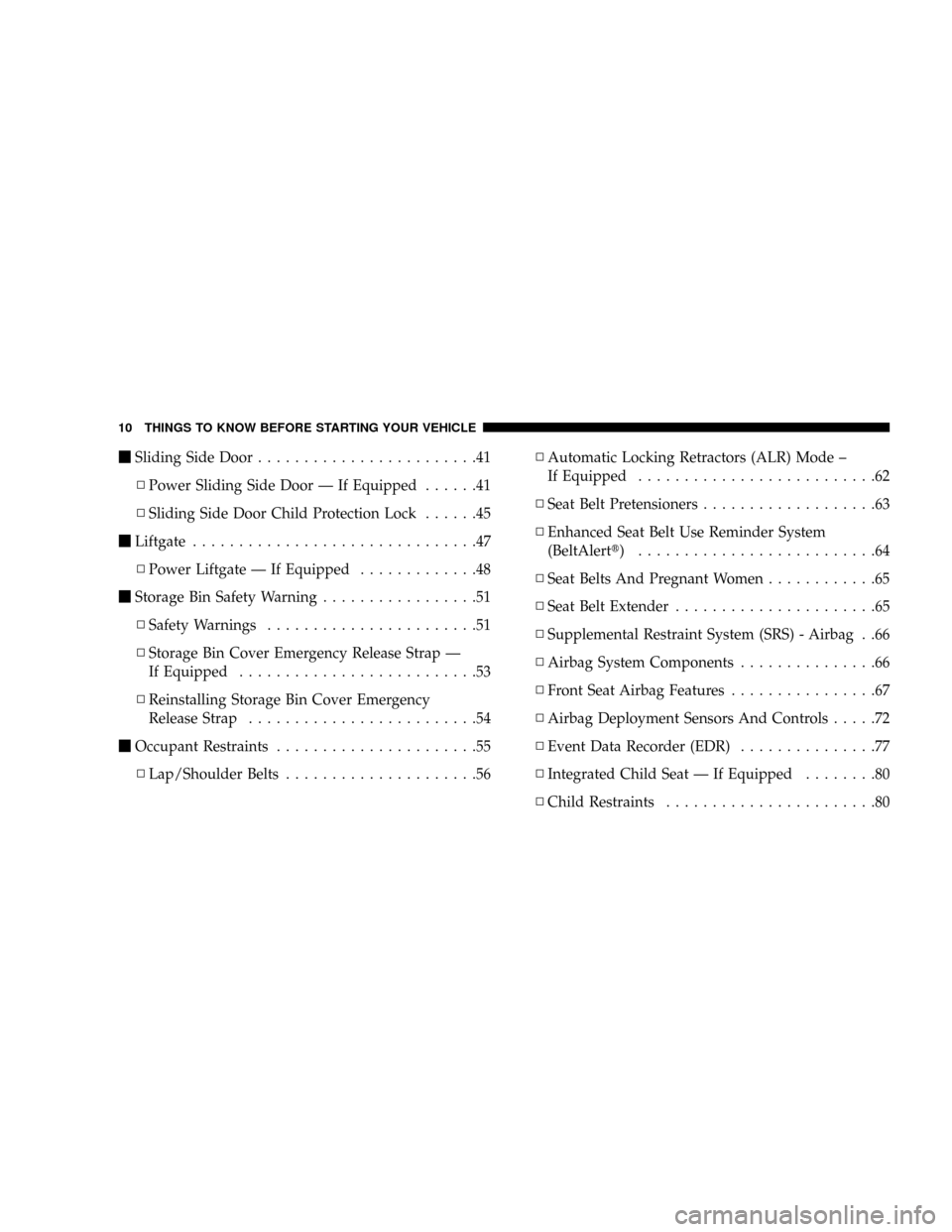
mSliding Side Door........................41
NPower Sliding Side Door Ð If Equipped......41
NSliding Side Door Child Protection Lock......45
mLiftgate...............................47
NPower Liftgate Ð If Equipped.............48
mStorage Bin Safety Warning.................51
NSafety Warnings.......................51
NStorage Bin Cover Emergency Release Strap Ð
If Equipped..........................53
NReinstalling Storage Bin Cover Emergency
Release Strap.........................54
mOccupant Restraints......................55
NLap/Shoulder Belts.....................56NAutomatic Locking Retractors (ALR) Mode ±
If Equipped..........................62
NSeat Belt Pretensioners...................63
NEnhanced Seat Belt Use Reminder System
(BeltAlertt) ..........................64
NSeat Belts And Pregnant Women............65
NSeat Belt Extender......................65
NSupplemental Restraint System (SRS) - Airbag . .66
NAirbag System Components...............66
NFront Seat Airbag Features................67
NAirbag Deployment Sensors And Controls.....72
NEvent Data Recorder (EDR)...............77
NIntegrated Child Seat Ð If Equipped........80
NChild Restraints.......................80
10 THINGS TO KNOW BEFORE STARTING YOUR VEHICLE
Page 13 of 531
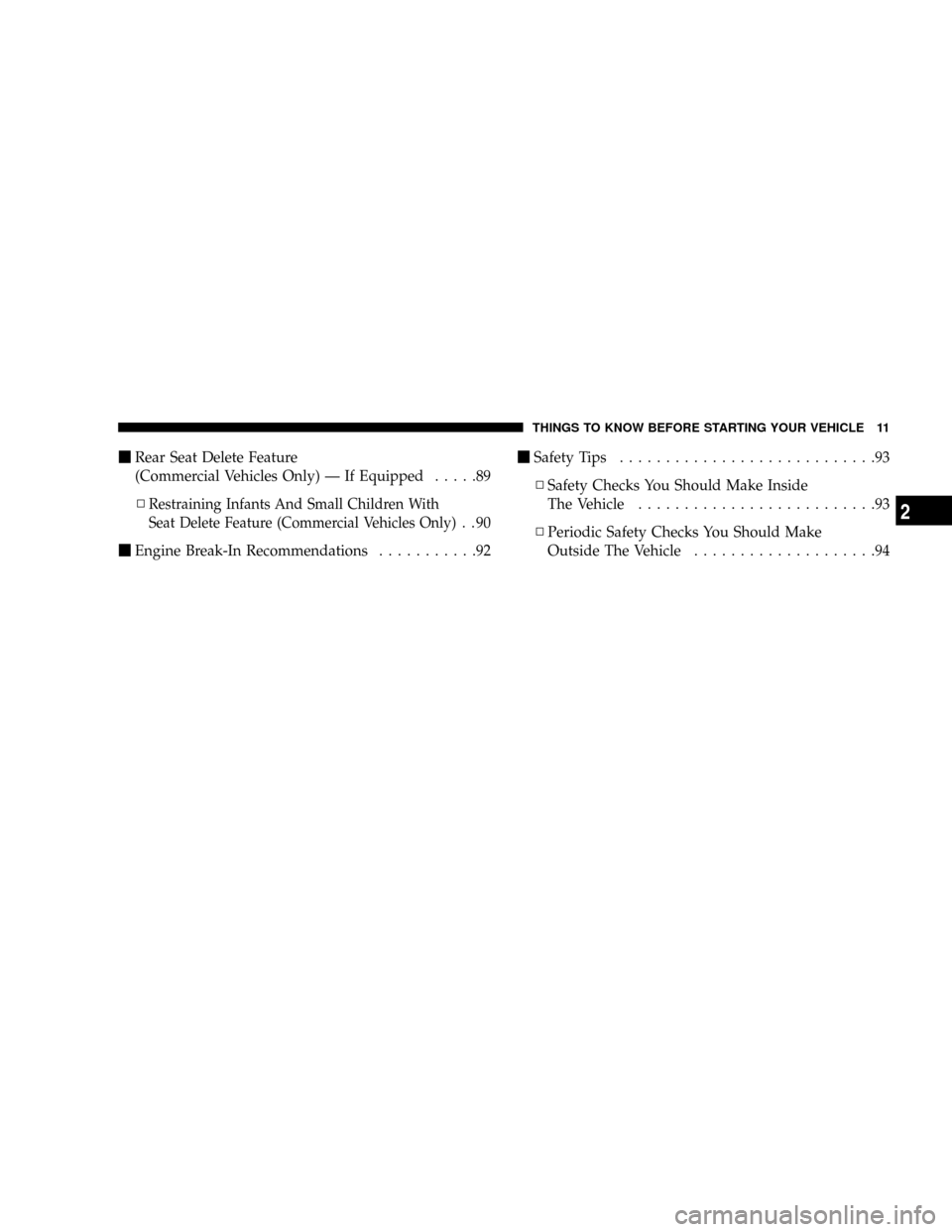
mRear Seat Delete Feature
(Commercial Vehicles Only) Ð If Equipped.....89
N
Restraining Infants And Small Children With
Seat Delete Feature (Commercial Vehicles Only)
..90
mEngine Break-In Recommendations...........92mSafety Tips............................93
NSafety Checks You Should Make Inside
The Vehicle..........................93
NPeriodic Safety Checks You Should Make
Outside The Vehicle....................94
THINGS TO KNOW BEFORE STARTING YOUR VEHICLE 11
2
Page 46 of 531
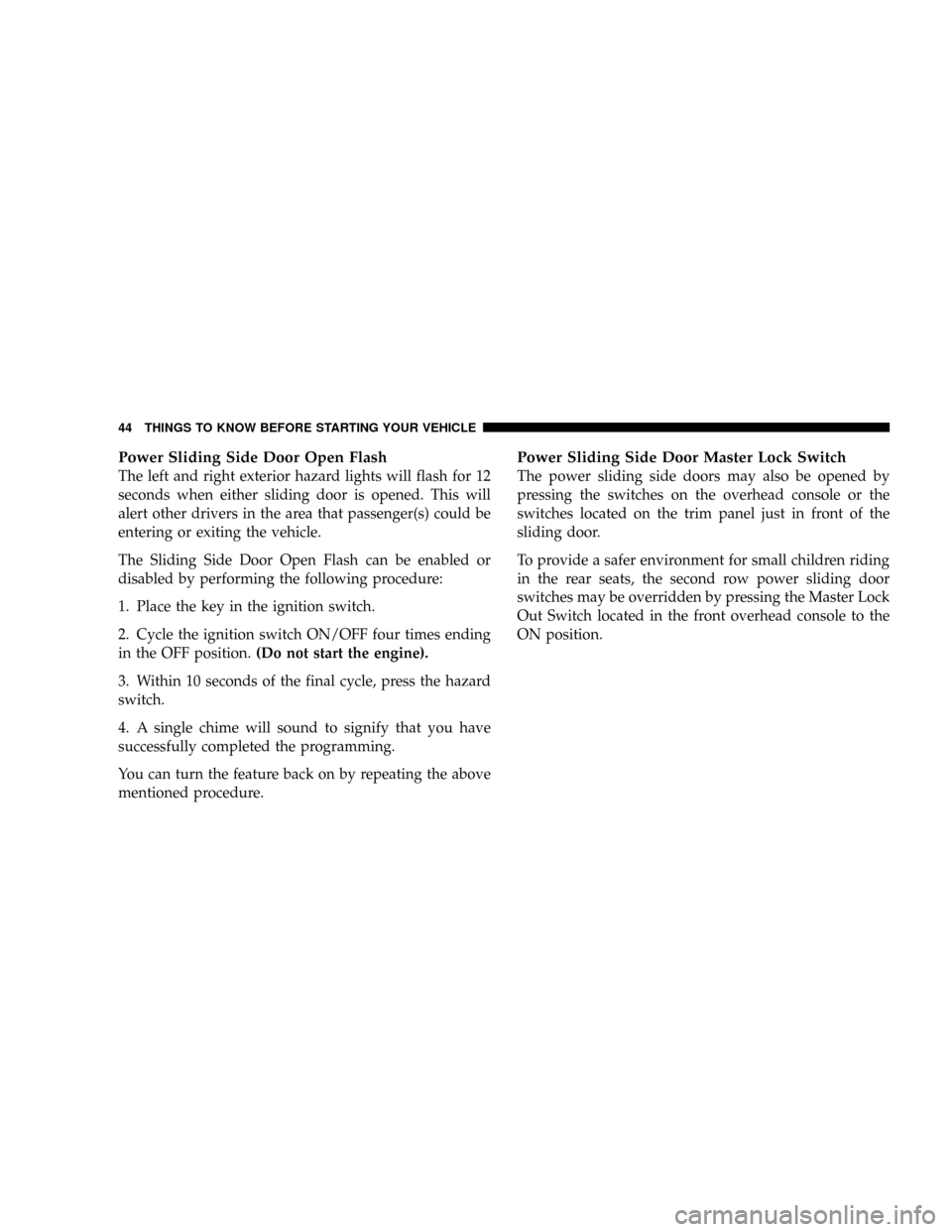
Power Sliding Side Door Open Flash
The left and right exterior hazard lights will flash for 12
seconds when either sliding door is opened. This will
alert other drivers in the area that passenger(s) could be
entering or exiting the vehicle.
The Sliding Side Door Open Flash can be enabled or
disabled by performing the following procedure:
1. Place the key in the ignition switch.
2. Cycle the ignition switch ON/OFF four times ending
in the OFF position.(Do not start the engine).
3. Within 10 seconds of the final cycle, press the hazard
switch.
4. A single chime will sound to signify that you have
successfully completed the programming.
You can turn the feature back on by repeating the above
mentioned procedure.
Power Sliding Side Door Master Lock Switch
The power sliding side doors may also be opened by
pressing the switches on the overhead console or the
switches located on the trim panel just in front of the
sliding door.
To provide a safer environment for small children riding
in the rear seats, the second row power sliding door
switches may be overridden by pressing the Master Lock
Out Switch located in the front overhead console to the
ON position.
44 THINGS TO KNOW BEFORE STARTING YOUR VEHICLE
Page 47 of 531
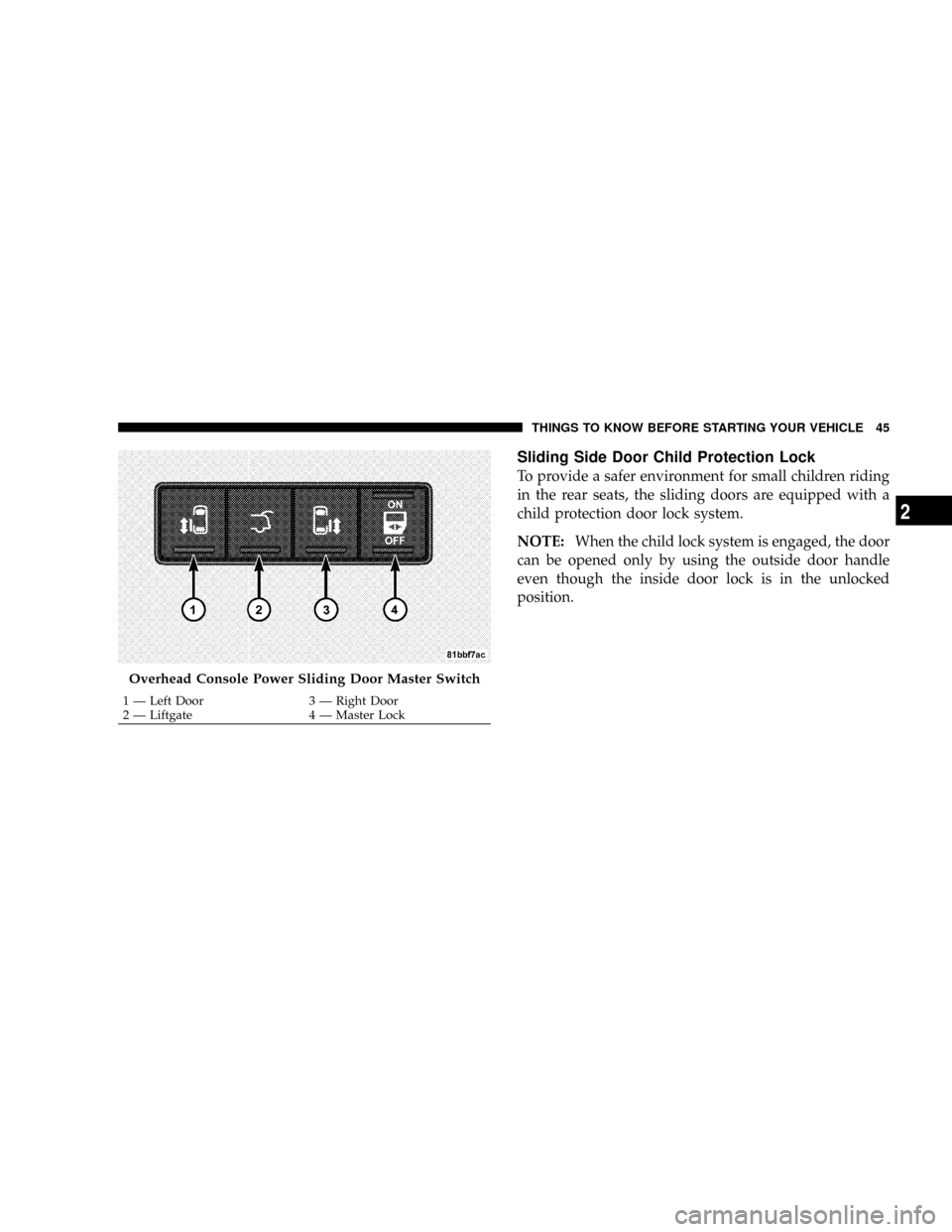
Sliding Side Door Child Protection Lock
To provide a safer environment for small children riding
in the rear seats, the sliding doors are equipped with a
child protection door lock system.
NOTE:When the child lock system is engaged, the door
can be opened only by using the outside door handle
even though the inside door lock is in the unlocked
position.
Overhead Console Power Sliding Door Master Switch
1 Ð Left Door 3 Ð Right Door
2 Ð Liftgate 4 Ð Master LockTHINGS TO KNOW BEFORE STARTING YOUR VEHICLE 45
2
Page 48 of 531
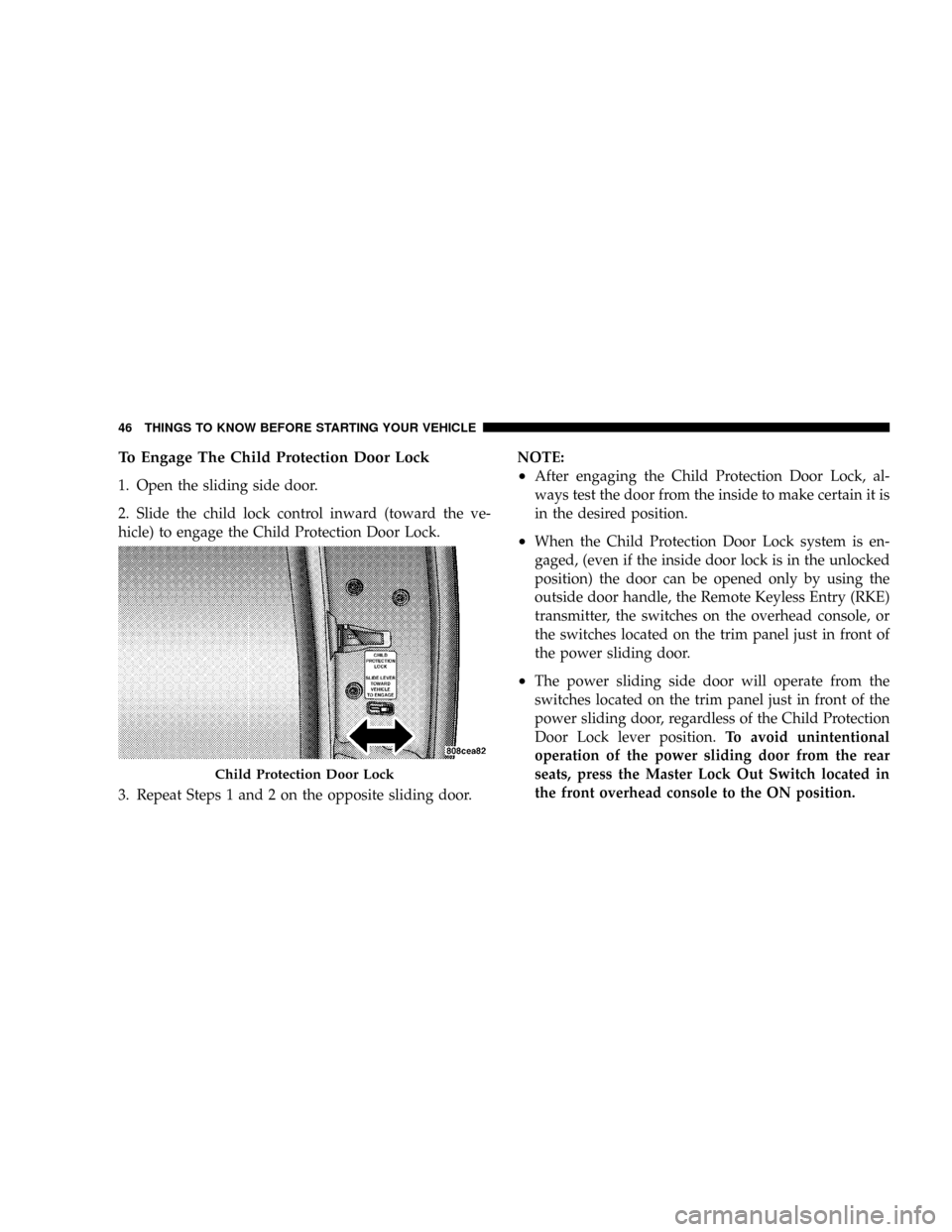
To Engage The Child Protection Door Lock
1. Open the sliding side door.
2. Slide the child lock control inward (toward the ve-
hicle) to engage the Child Protection Door Lock.
3. Repeat Steps 1 and 2 on the opposite sliding door.NOTE:²After engaging the Child Protection Door Lock, al-
ways test the door from the inside to make certain it is
in the desired position.
²When the Child Protection Door Lock system is en-
gaged, (even if the inside door lock is in the unlocked
position) the door can be opened only by using the
outside door handle, the Remote Keyless Entry (RKE)
transmitter, the switches on the overhead console, or
the switches located on the trim panel just in front of
the power sliding door.
²The power sliding side door will operate from the
switches located on the trim panel just in front of the
power sliding door, regardless of the Child Protection
Door Lock lever position.To avoid unintentional
operation of the power sliding door from the rear
seats, press the Master Lock Out Switch located in
the front overhead console to the ON position.
Child Protection Door Lock
46 THINGS TO KNOW BEFORE STARTING YOUR VEHICLE
Page 53 of 531
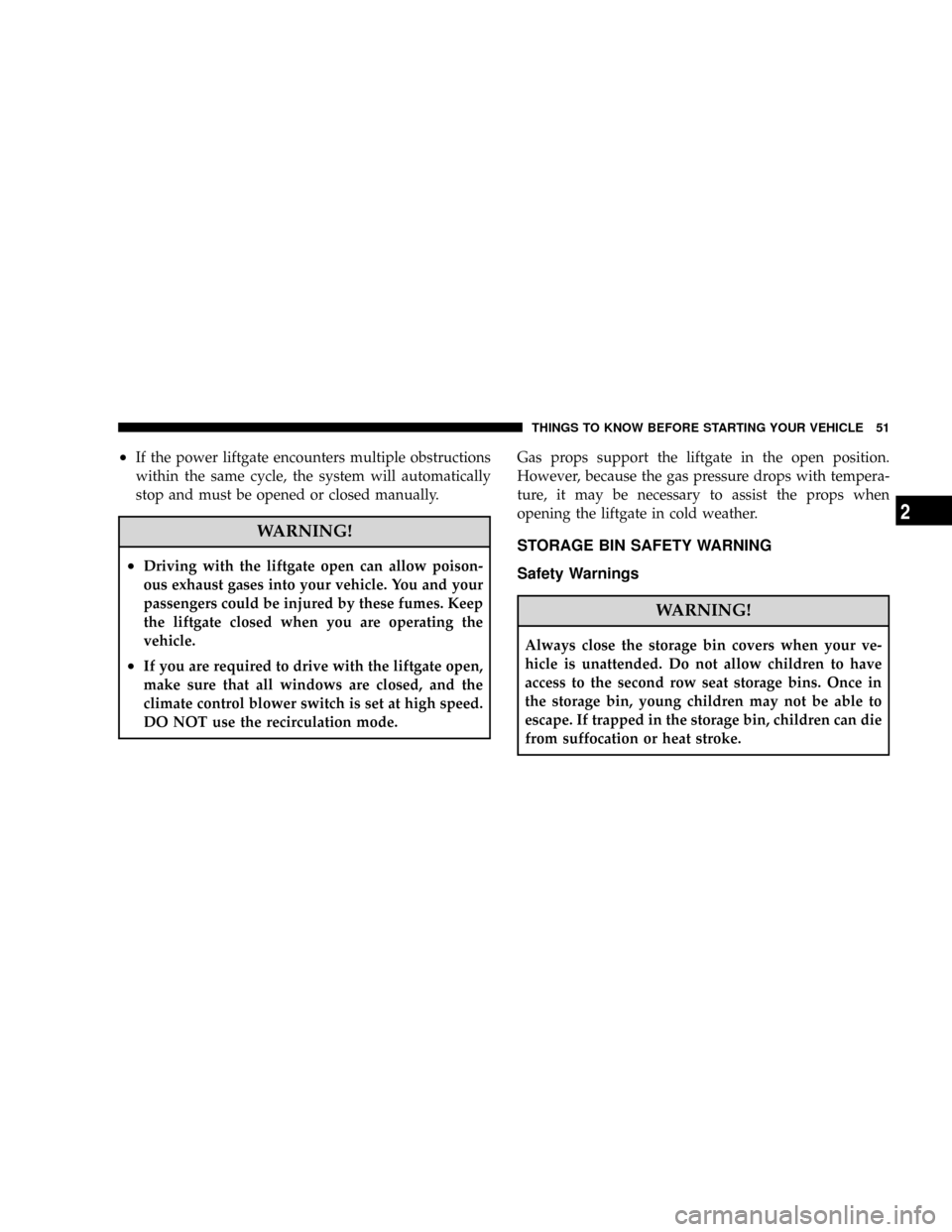
²If the power liftgate encounters multiple obstructions
within the same cycle, the system will automatically
stop and must be opened or closed manually.
WARNING!
²Driving with the liftgate open can allow poison-
ous exhaust gases into your vehicle. You and your
passengers could be injured by these fumes. Keep
the liftgate closed when you are operating the
vehicle.
²If you are required to drive with the liftgate open,
make sure that all windows are closed, and the
climate control blower switch is set at high speed.
DO NOT use the recirculation mode.Gas props support the liftgate in the open position.
However, because the gas pressure drops with tempera-
ture, it may be necessary to assist the props when
opening the liftgate in cold weather.
STORAGE BIN SAFETY WARNING
Safety Warnings
WARNING!
Always close the storage bin covers when your ve-
hicle is unattended. Do not allow children to have
access to the second row seat storage bins. Once in
the storage bin, young children may not be able to
escape. If trapped in the storage bin, children can die
from suffocation or heat stroke.
THINGS TO KNOW BEFORE STARTING YOUR VEHICLE 51
2
Page 57 of 531
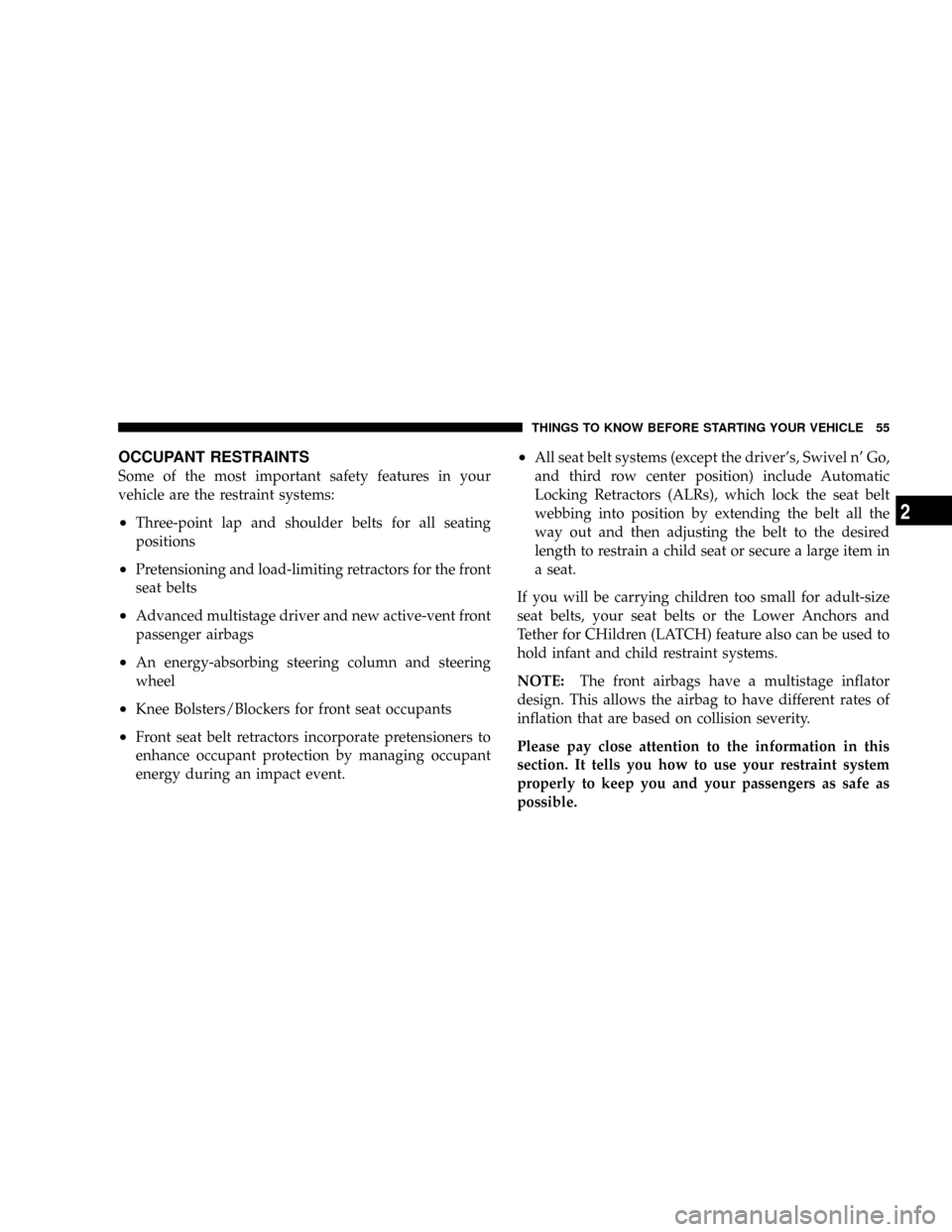
OCCUPANT RESTRAINTS
Some of the most important safety features in your
vehicle are the restraint systems:
²Three-point lap and shoulder belts for all seating
positions
²Pretensioning and load-limiting retractors for the front
seat belts
²Advanced multistage driver and new active-vent front
passenger airbags
²An energy-absorbing steering column and steering
wheel
²Knee Bolsters/Blockers for front seat occupants
²Front seat belt retractors incorporate pretensioners to
enhance occupant protection by managing occupant
energy during an impact event.
²All seat belt systems (except the driver's, Swivel n' Go,
and third row center position) include Automatic
Locking Retractors (ALRs), which lock the seat belt
webbing into position by extending the belt all the
way out and then adjusting the belt to the desired
length to restrain a child seat or secure a large item in
a seat.
If you will be carrying children too small for adult-size
seat belts, your seat belts or the Lower Anchors and
Tether for CHildren (LATCH) feature also can be used to
hold infant and child restraint systems.
NOTE:The front airbags have a multistage inflator
design. This allows the airbag to have different rates of
inflation that are based on collision severity.
Please pay close attention to the information in this
section. It tells you how to use your restraint system
properly to keep you and your passengers as safe as
possible.
THINGS TO KNOW BEFORE STARTING YOUR VEHICLE 55
2
Page 65 of 531
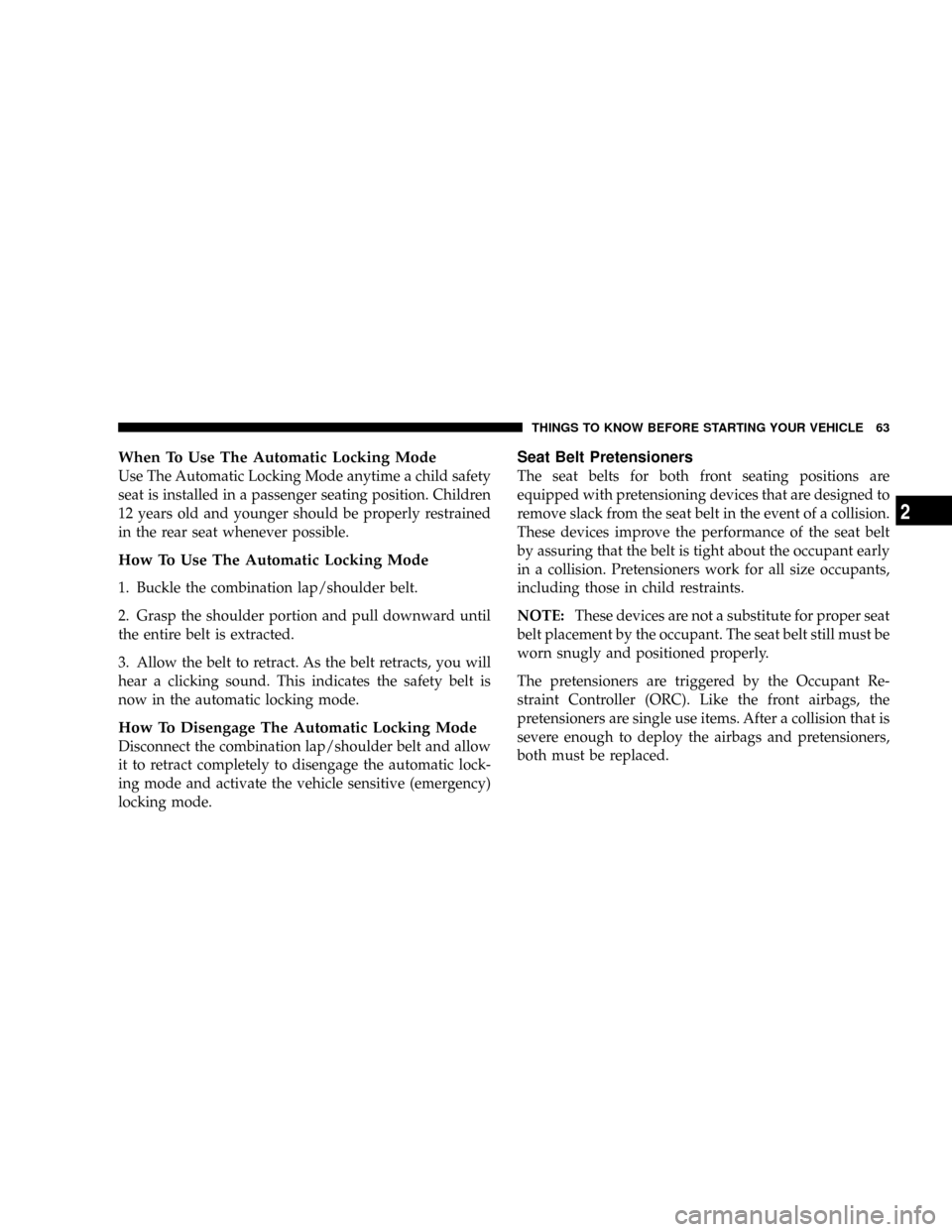
When To Use The Automatic Locking Mode
Use The Automatic Locking Mode anytime a child safety
seat is installed in a passenger seating position. Children
12 years old and younger should be properly restrained
in the rear seat whenever possible.
How To Use The Automatic Locking Mode
1. Buckle the combination lap/shoulder belt.
2. Grasp the shoulder portion and pull downward until
the entire belt is extracted.
3. Allow the belt to retract. As the belt retracts, you will
hear a clicking sound. This indicates the safety belt is
now in the automatic locking mode.
How To Disengage The Automatic Locking Mode
Disconnect the combination lap/shoulder belt and allow
it to retract completely to disengage the automatic lock-
ing mode and activate the vehicle sensitive (emergency)
locking mode.
Seat Belt Pretensioners
The seat belts for both front seating positions are
equipped with pretensioning devices that are designed to
remove slack from the seat belt in the event of a collision.
These devices improve the performance of the seat belt
by assuring that the belt is tight about the occupant early
in a collision. Pretensioners work for all size occupants,
including those in child restraints.
NOTE:These devices are not a substitute for proper seat
belt placement by the occupant. The seat belt still must be
worn snugly and positioned properly.
The pretensioners are triggered by the Occupant Re-
straint Controller (ORC). Like the front airbags, the
pretensioners are single use items. After a collision that is
severe enough to deploy the airbags and pretensioners,
both must be replaced.
THINGS TO KNOW BEFORE STARTING YOUR VEHICLE 63
2
Page 72 of 531
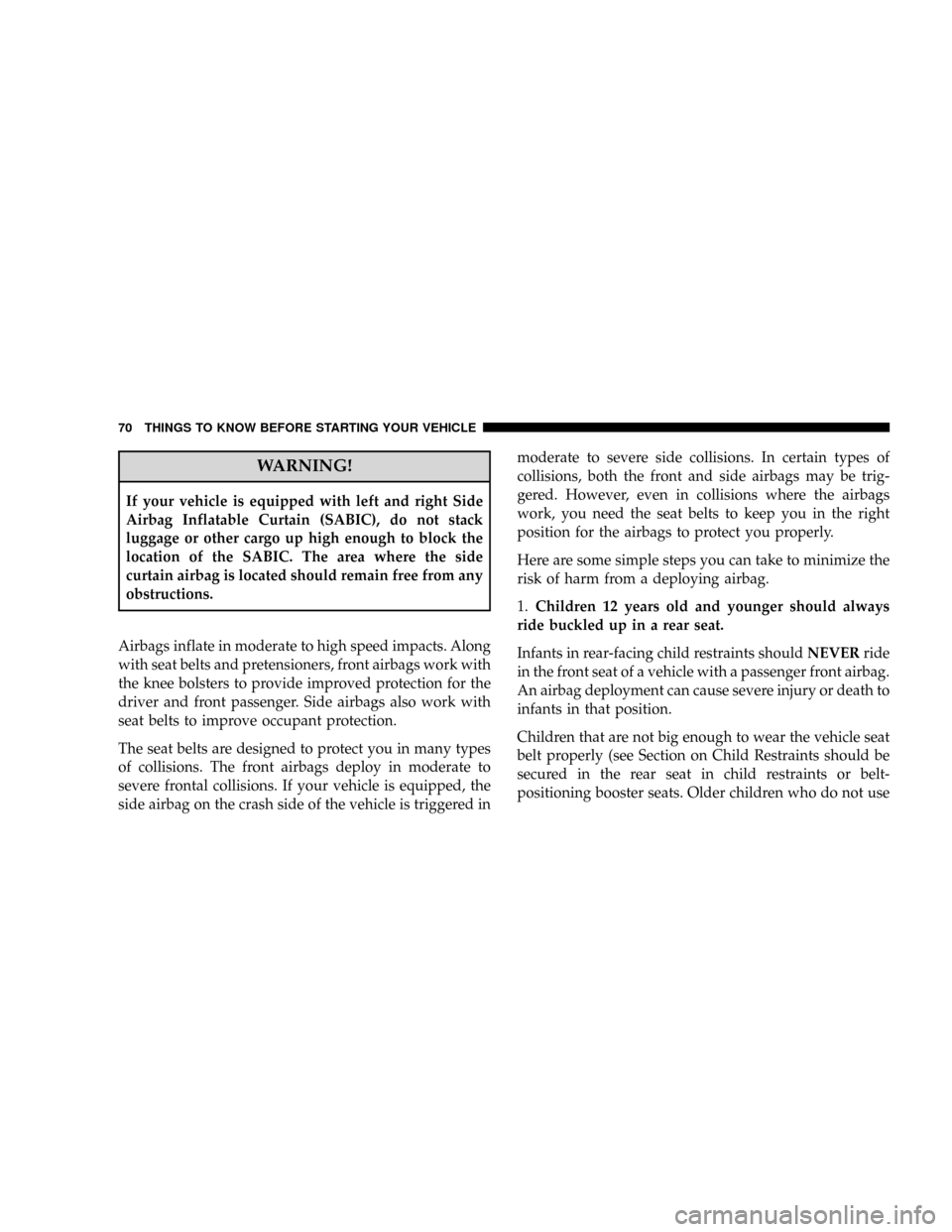
WARNING!
If your vehicle is equipped with left and right Side
Airbag Inflatable Curtain (SABIC), do not stack
luggage or other cargo up high enough to block the
location of the SABIC. The area where the side
curtain airbag is located should remain free from any
obstructions.
Airbags inflate in moderate to high speed impacts. Along
with seat belts and pretensioners, front airbags work with
the knee bolsters to provide improved protection for the
driver and front passenger. Side airbags also work with
seat belts to improve occupant protection.
The seat belts are designed to protect you in many types
of collisions. The front airbags deploy in moderate to
severe frontal collisions. If your vehicle is equipped, the
side airbag on the crash side of the vehicle is triggered inmoderate to severe side collisions. In certain types of
collisions, both the front and side airbags may be trig-
gered. However, even in collisions where the airbags
work, you need the seat belts to keep you in the right
position for the airbags to protect you properly.
Here are some simple steps you can take to minimize the
risk of harm from a deploying airbag.
1.Children 12 years old and younger should always
ride buckled up in a rear seat.
Infants in rear-facing child restraints shouldNEVERride
in the front seat of a vehicle with a passenger front airbag.
An airbag deployment can cause severe injury or death to
infants in that position.
Children that are not big enough to wear the vehicle seat
belt properly (see Section on Child Restraints should be
secured in the rear seat in child restraints or belt-
positioning booster seats. Older children who do not use
70 THINGS TO KNOW BEFORE STARTING YOUR VEHICLE
Page 73 of 531
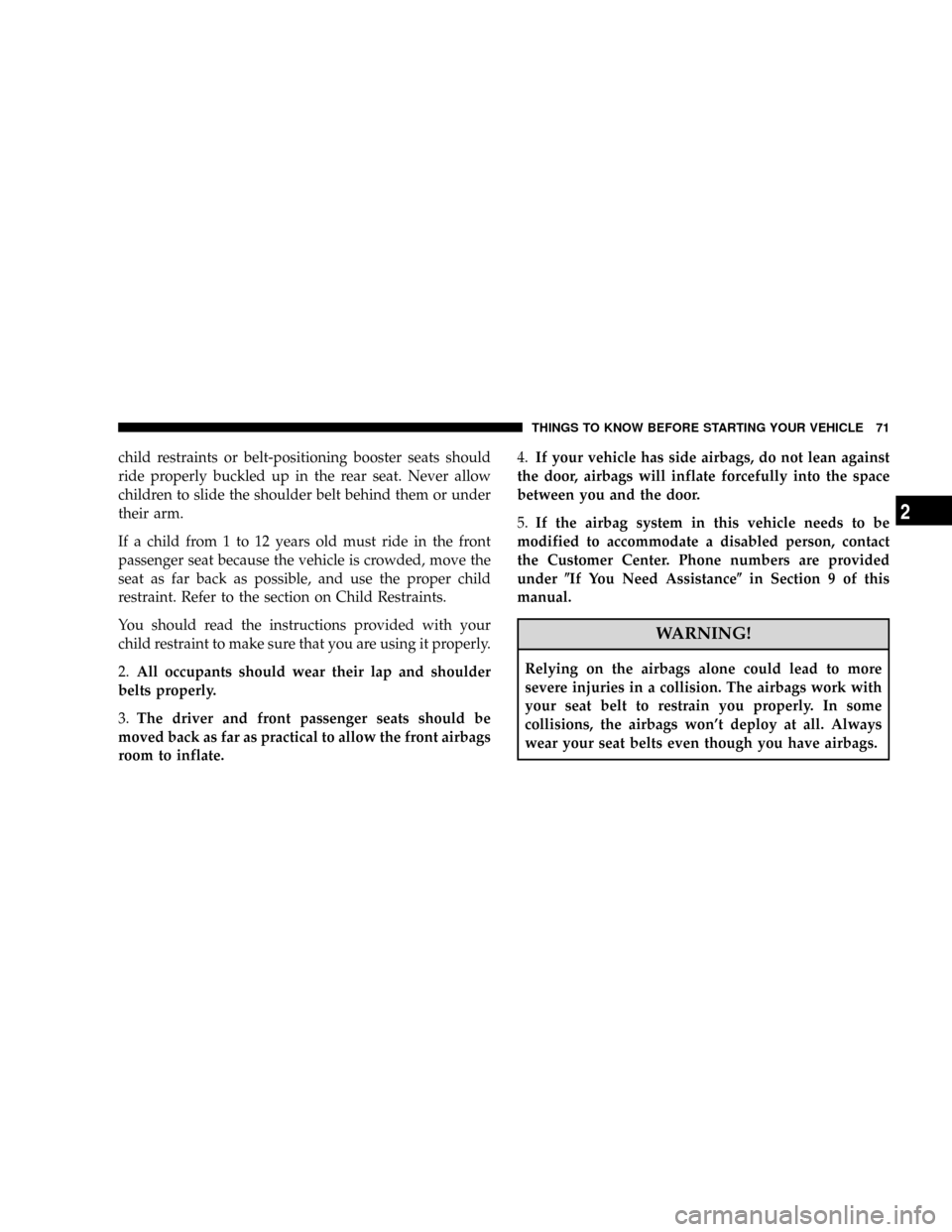
child restraints or belt-positioning booster seats should
ride properly buckled up in the rear seat. Never allow
children to slide the shoulder belt behind them or under
their arm.
If a child from 1 to 12 years old must ride in the front
passenger seat because the vehicle is crowded, move the
seat as far back as possible, and use the proper child
restraint. Refer to the section on Child Restraints.
You should read the instructions provided with your
child restraint to make sure that you are using it properly.
2.All occupants should wear their lap and shoulder
belts properly.
3.The driver and front passenger seats should be
moved back as far as practical to allow the front airbags
room to inflate.4.If your vehicle has side airbags, do not lean against
the door, airbags will inflate forcefully into the space
between you and the door.
5.If the airbag system in this vehicle needs to be
modified to accommodate a disabled person, contact
the Customer Center. Phone numbers are provided
under(If You Need Assistance(in Section 9 of this
manual.
WARNING!
Relying on the airbags alone could lead to more
severe injuries in a collision. The airbags work with
your seat belt to restrain you properly. In some
collisions, the airbags won't deploy at all. Always
wear your seat belts even though you have airbags.
THINGS TO KNOW BEFORE STARTING YOUR VEHICLE 71
2